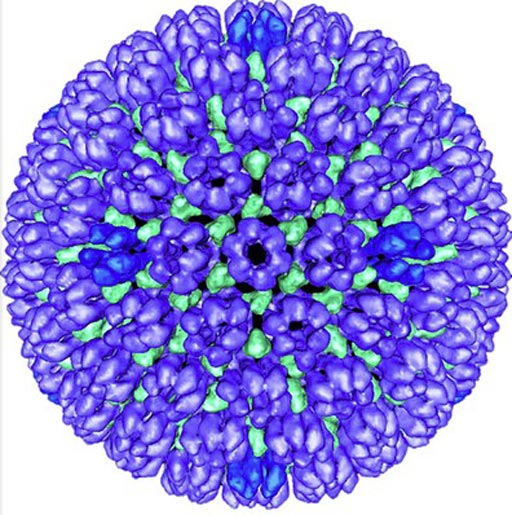Study Highlights Long-Term Continuity of HSV
By LabMedica International staff writers
Posted on 31 Oct 2017
A team of molecular virologists traced the physical and genetic variations expressed by herpes simplex virus following an infection that had been passed from a father to his son.Posted on 31 Oct 2017
High throughput genomic sequencing has provided an unprecedented view of the circulating diversity of all classes of human herpes viruses. Previously published sequence data has demonstrated diversity of herpes simplex virus 1 (HSV-1) between different hosts. However the extent of variation during transmission events, or in one host over years of chronic infection, remain unknown.

Image: The outer protein shell (procapsid) of the herpes simplex virus type 1 (HSV-1) (Photo courtesy of Dr. Bernard Heymann).
In a recent study, investigators at Pennsylvania State University (University Park, USA) presented an initial example of full characterization of viruses isolated from a father to son transmission event. The likely occasion of transmission occurred 17 years before the strains were isolated, enabling a first view of the degree of virus conservation after decades of recurrences, including transmission and adaptation to a new host.
The investigators employed genetic mapping techniques to sequence the full viral genome and examined each virus in a mouse ocular model of infection to compare the level of virulence.
They reported in the October 20, 2017, online edition of the journal Scientific Reports that these two viruses preserved the genotype nearly perfectly during transmission from father to son, and during nearly two decades of episodes of recurrent disease in each human host. The viruses also had similar pathology when tested in mice, as they grew at a similar rate and had a similar ability to set up long-term infection in the brain.
“Millions of people worldwide have herpes simplex virus,” said contributing author Dr. Moriah Szpara, assistant professor of biochemistry and molecular biology at Pennsylvania State University. “We see locally distinct variants of the virus with distinct genetic fingerprints in different regions around the world, and, with the prevalence of international travel, we are starting to see a lot of different variants of the virus appearing in one place. This could have implications for how the virus evolves and how we design therapeutics to combat it. Studies of a related virus - human cytomegalovirus - suggest that the virus diversifies after transmission, and we wanted to see if this was also the case for herpes simplex virus.”
“This study broadens our knowledge of what herpes simplex virus variants are circulating in the U.S,” said Dr. Szpara. “It is not just the United States/European variants that are used in vaccine development and clinical studies. When we think about designing therapeutics and vaccines, we need to know how the virus can differ or we may design something that only controls the virus from a particular region. If we could understand how much the virus changes when passed between unrelated individuals and how the virus’ genetics influences the level of virulence or level of harm the virus can do, then hopefully we can design better treatments for HSV-1.”
Related Links:
Pennsylvania State University













